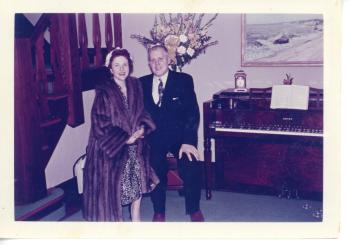Myron "Mike" and Helen Van Essendelft

Long Island Traditions
Folklorist Nancy Solomon has documented the maritime culture of Long Island through these interviews spanning the years 1987 – 2016. The collection includes baymen, fishermen, boat builders and other maritime tradition bearers.
On February 4 & 5, 2004, Nancy Solomon interviewed Mike and Helen Van Essendelft as part of the Long Island Traditions Oral History Collection. Mike and Helen are long-time members of the West Sayville community, and both participated in the local clamming and oystering industry. Mike discusses the history of the Dutch community in West Sayville, including stories of prominent figures and the creation of Bluepoints Oyster Company, where he worked for 12 years. He and Helen recall major moments of change for the West Sayville fishing industry, including the 1938 hurricane and its lasting environmental impacts, the increased availability of cars, and expansion of paved roads and highways.
Please Note: The oral histories in this collection are protected by copyright and have been created for educational, research and personal use as described by the Fair Use Doctrine in the U.S. Copyright law. Please reach out Voices@noaa.gov to let us know how these interviews are being used in your research, project, exhibit, etc. The Voices staff can help provide other useful resources related to your inquiry.
The NOAA mission is to understand and predict changes in climate, weather, oceans, and coasts, to share that knowledge and information with others, and to conserve and manage coastal and marine ecosystems and resources. The Voices Oral History Archives offers public access to a wide range of accounts, including historical materials that are products of their particular times, and may contain offensive language or negative stereotypes.
Voices Oral History Archives does not verify the accuracy of materials submitted to us. The opinions expressed in the interviews are those of the interviewee only. The interviews here have been made available to the public only after the interviewer has confirmed that they have obtained consent.
